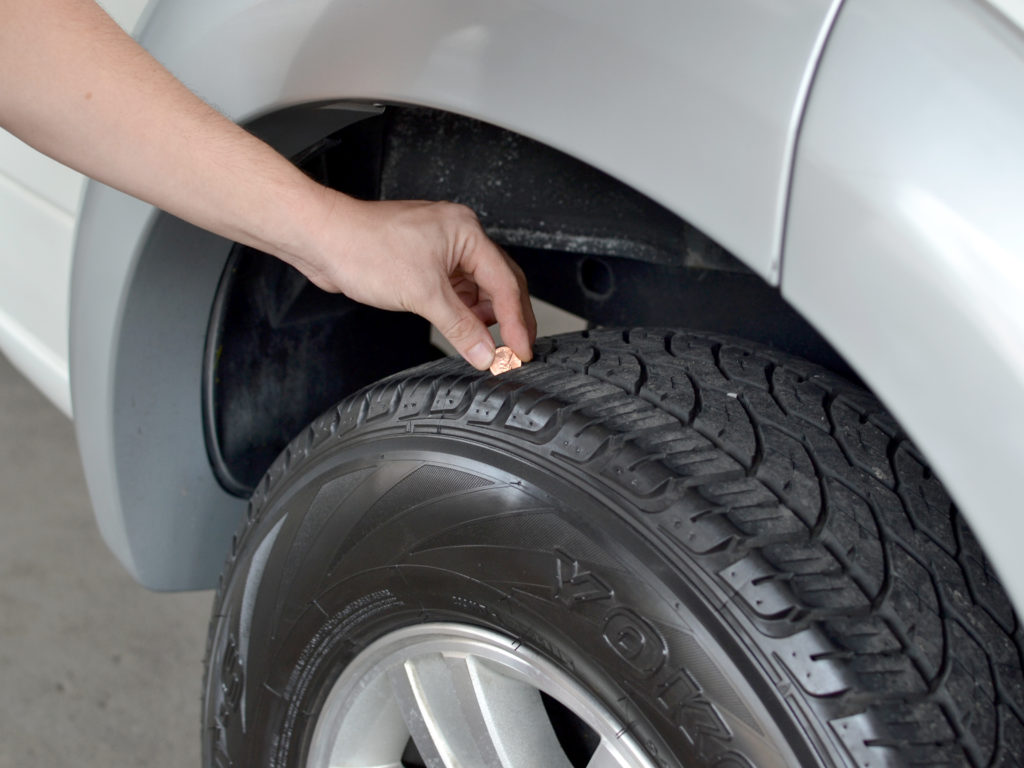Tire tread has the capacity to affect your vehicle’s safety and performance while on the go. While you might not think about your tire tread every time you drive, it is important to check in every once in a while to ensure that your tires are in good working order. Ready to talk about tire tread depth? Let’s dive in.
The tread depth of the tire is a vertical measurement between the top of the tread and the lowest groove. In the U.S., tire tread depth is measured in 32nds of an inch. When tires are brand new, they have tread depths from 10/32 to 11/32.
In the United States, tires are required by law to have easily recognizable tread wear indicators. As the tire tread wears down, it eventually becomes level with the tread wear indicator. At this point, the tire should be replaced. It has too little tread left to provide traction. If safety weren’t persuasive enough, keep in mind that it is also illegal to drive with bald tires.
The minimum legal limit is 2/32 of an inch. This doesn’t mean that tires are perfectly safe if they have 3/32 left of tread. This is simply the limit at which you won’t pass your state safety inspection. Your tires become incrementally less safe as the tread wears down.
When it comes to safety, your tires are literally where the rubber meets the road. Sufficient tire tread depth is necessary for safe turning and braking.
Low tire tread depth can spell disaster for your drive, including:
If you live in an area where it rains or snows frequently, consider replacing tires when they reach 4/32 of an inch. With worn tires, you are at risk of hydroplaning on wet roads. This is when the tire can’t channel the water through the grooves. The car rides along the top of the water instead of staying in contact with the asphalt. As such, the tires can’t respond to the steering system. If you have experienced it, you know how terrifying it can be. In icy or snowy conditions, low tread depth makes it harder to stop. You can also fishtail when accelerating or slide sideways when turning.
This is when the tire can’t channel the water through the grooves. The car rides along the top of the water instead of staying in contact with the asphalt. As such, the tires can’t respond to the steering system. If you have experienced it, you know how terrifying it can be. In icy or snowy conditions, low tread depth makes it harder to stop. You can also fishtail when accelerating or slide sideways when turning.
There are special considerations for driving in hot weather as well. If you are heading into summer and your tires are near the end of their lifespan, be aware that they wear down faster on hot roads.
Easy peasy. All you need to check your tire tread depth is a penny. Insert the penny with Abraham Lincoln’s head upside down. If the top of Abe’s head is showing, it’s time for new tires. Tamara shows you how to do it in this video.
Be thorough when you measure your tread depth. Insert the penny in several places around the tire. It’s not uncommon to have uneven tread wear. Measuring in several places will compensate for this.
Insert the penny in several places around the tire. It’s not uncommon to have uneven tread wear. Measuring in several places will compensate for this.
Having the proper air pressure in your tires is also critical. Tire air pressure is expressed as a number followed by PSI. This stands for pounds per square inch. 28 PSI means 28 pounds per square inch. It is a measurement of the force inside the tire applied to one square inch. You can check the recommended tire pressure for your car in your owner’s manual or on a sticker inside the driver’s side door. For most vehicles, it is around 32 PSI.
If your pressure is too low, your tires will wear out quicker. You will also get poorer gas mileage. This is because it’s harder for your engine to propel a vehicle riding on squishy tires. Low tire air pressure also results in a jerkier ride. Thankfully, there are plenty of easy ways to score a free tire pressure refill.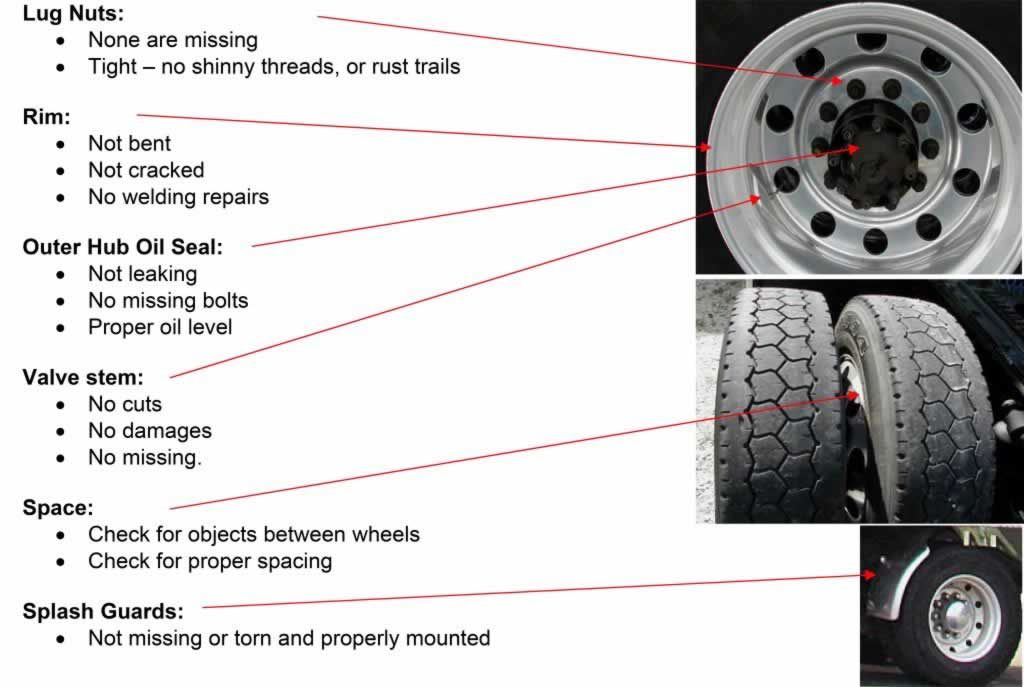
If you discover that your tires are too low, fill to the correct pressure. Don’t assume ‘more is better’. There are problems with overinflation as well. When a tire has too much air, it doesn’t have as much surface area in contact with the pavement. This makes it more difficult to handle. It also increases the risk of a blowout. At high speeds, a blowout can be deadly.
Since the early 1970s, the National Highway Traffic Safety Administration (NHTSA) and international counterparts were concerned about the dangers of low air pressure. They were seeking technology that could warn drivers. Evidence was mounting that underinflated tires were a factor in thousands of car accidents each year. At the end of the decade, the NHTSA was also motivated by the energy crisis. Tire air pressure affects fuel economy.
Tire pressure sensing technology became available in the 1980s and was first used by Porsche on the 1987 Porsche 959.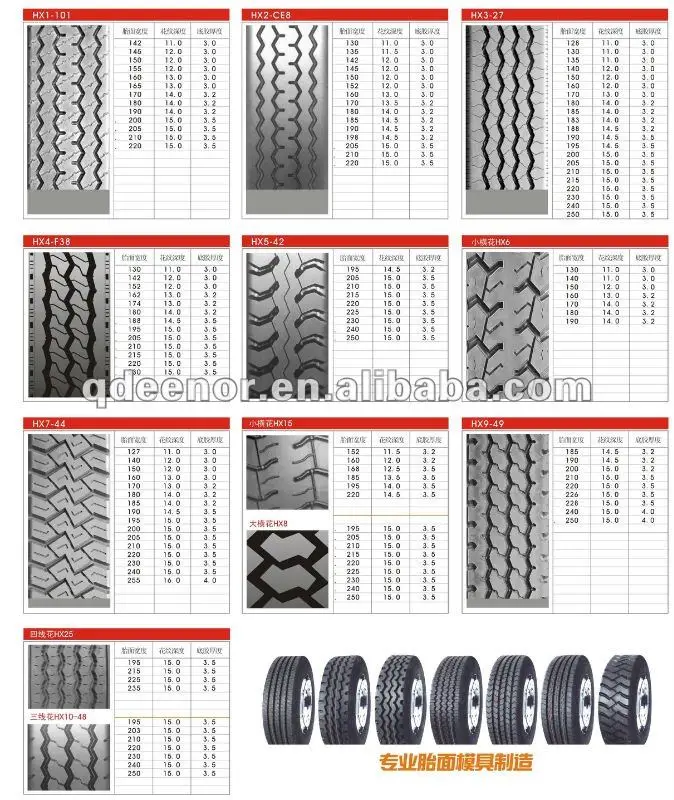 In the U.S., TPMS was federally mandated beginning with the 2007 model year.
In the U.S., TPMS was federally mandated beginning with the 2007 model year.
There are two types of TPMS, indirect and direct. Direct pressure detectors are located on the tire stems. If the sensor detects a significant drop in pressure, it sends an alert to the engine computer—resulting in a dashboard warning light. The indirect type uses the antilock brake system to detect low pressure by measuring wheel speed. Tires revolve at different speeds depending on air pressure. The indirect method is less reliable and has been largely phased out among manufacturers.
At Chapel Hill Tire, we have been providing professional automotive service to North Carolina drivers since 1953. We help our valued clients choose the right tire and protect their tire investment with alignment and wheel balancing services.
Do you need new tires in Cary, Apex, Carrboro, Chapel Hill, Raleigh, or Durham? Our experts can help you find the right tires for your vehicle at the lowest possible price.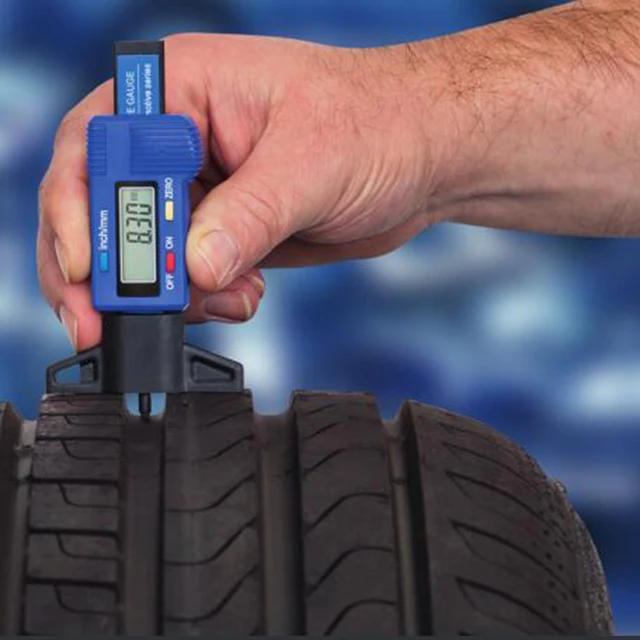 With our Price Beat Guarantee, you can ensure you are getting the best possible price on new tires in the Triangle. Schedule an appointment at one of our 10 Triangle-area service centers. We look forward to welcoming you to Chapel Hill Tire!
With our Price Beat Guarantee, you can ensure you are getting the best possible price on new tires in the Triangle. Schedule an appointment at one of our 10 Triangle-area service centers. We look forward to welcoming you to Chapel Hill Tire!
Back to Resources
by Emma Watkins
Vintage Car Engine image by itsallgood from Fotolia.com
The Pennsylvania Department of Transportation (PDOT) has established a series of inspection requirements all motor vehicles must pass to be registered in that state. The points of inspection vary depending on the type of vehicle you own. Passenger cars and light duty trucks fall in the same category and have the same parts checked for potential problems. The PDOT publishes detailed information about its mandatory inspections.
The car's ball joint movement can't exceed the manufacturer's specifications, along with shock absorbers that do not leak. Their mounting bolts can't be broken and there has to be a stabilizer bar.
Their mounting bolts can't be broken and there has to be a stabilizer bar.
The steering gear box can't be loose on the frame and the steering cannot be constrained or limited. When you steer, the wheels should respond appropriately.
The brakes' hydraulic hose, wheel cylinder and caliper shouldn't leak or show mechanical damage. The inspector will also check the size of the drum and disc thickness to verify they haven't been replaced with incorrect ones.
Two adjacent tire treads can't have less than 2/32 inches of tread left. In addition, your car will fail inspection if any of the tires has been fixed with a blow-up patch, has a bulge, a bump or separation. You also need tires that are designated safe for highway use. Two tires that share the same axle, have to be the same size and type. The wheels can't be bent, cracked or welded and must have all their nuts and bolts. The inspector will also verify that your back wheels track the front wheels in a straight ahead position.
Every lamp and switch in your car needs to turn on and off. Headlamps have to have a low beam and a high beam. In addition, you should have one red stop lamp on each side of the rear of your car. Other required lamps are: parking, tail, hazard warning, back up and turn signals. The car also has to be equipped with a secure fastening system to hold the battery safely in place.
A car's windshield and windows need safety glazing. Only government issued stickers can go on the lower left or right corner of the windshield. There also must be at least one rear view mirror without any ornaments hanging from it.
The defrosters and wipers have to be in working condition. Wipers should be able to remove both snow and water from the windshield surface and the car also has to be equipped with a windshield washer system.
All parts of your car's fuel system have to be leak proof and safely fastened to the vehicle.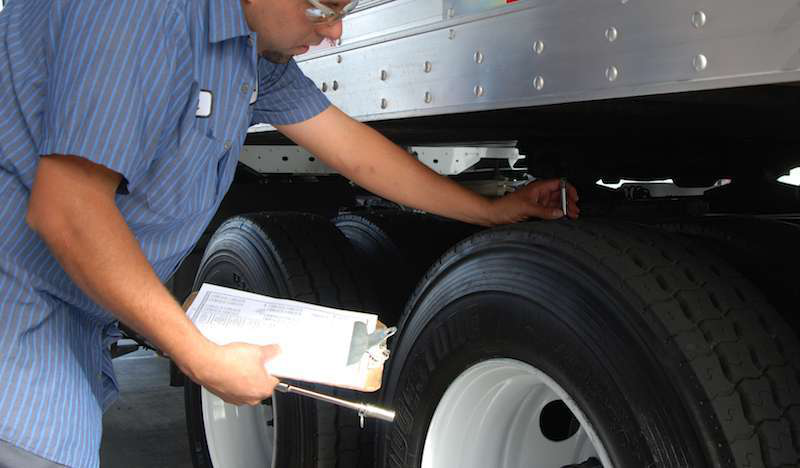 Your engine has to return to idle when you step off the accelerator pedal, along with the required cap for the gas tank.
Your engine has to return to idle when you step off the accelerator pedal, along with the required cap for the gas tank.
Your speedometer has to be calibrated to show miles or kilometers per hour. Your car also needs an odometer that's calibrated to tell you how many miles you've driven.
The car's exhaust system shouldn't allow any gases to be released into the vehicle and should have a muffler that adequately suppresses excessive noise.
While your car is required to have a horn in good operating condition, only emergency vehicles can have sirens. Horns are for warning only and you may be fined if you misuse it.
The following parts need to be present for your car to pass inspection: fenders, hood and hood latches, and doors that open and close securely. Your chassis also has to be in perfect condition without cracks, missing parts or any damage along with flooring and bumpers.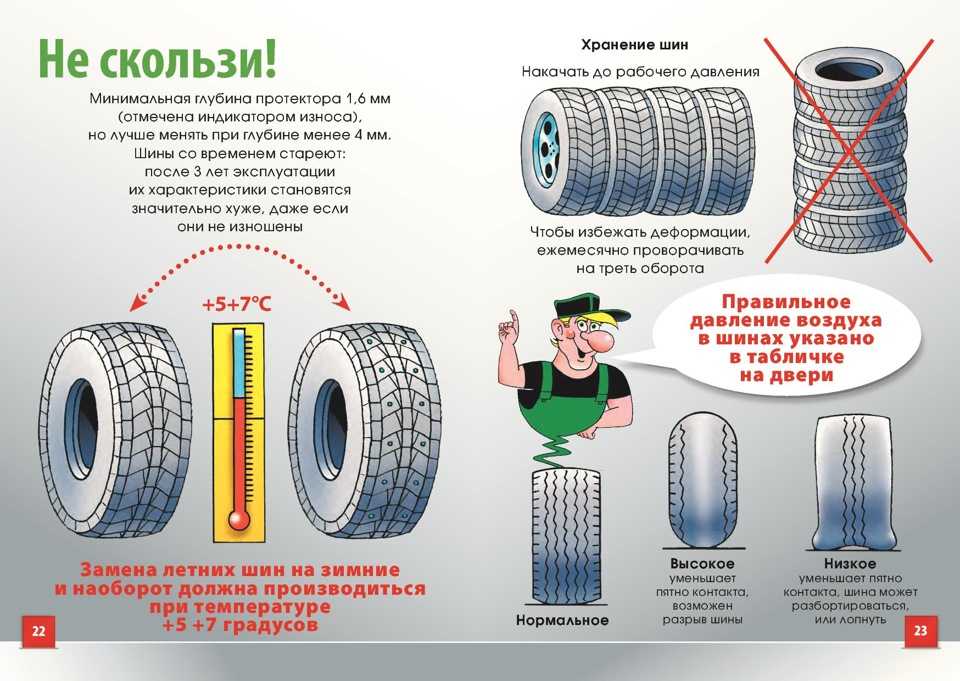
References
Writer Bio
Emma Watkins writes on finance, fitness and gardening. Her articles and essays have appeared in "Writer's Digest," "The Writer," "From House to Home," "Big Apple Parent" and other online and print venues. Watkins holds a Master of Arts in psychology.
07/13/2021
Passing inspection for many car owners has always been a problem. But, if earlier the main attention was paid to the condition of the body and chassis of the car, today the wheels have also been included in the list of mandatory elements of the check. At the same time, in this case, tougher requirements are applied to the wheels for undergoing maintenance, which make it impossible for many drivers to receive a diagnostic card. To avoid such a situation and guaranteed to pass the technical inspection of the vehicle, it is necessary to take into account a number of specific maintenance requirements.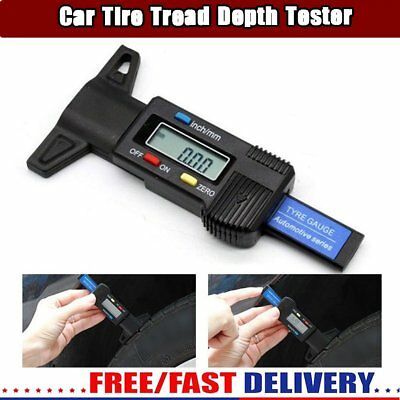
Technical inspection is a responsible procedure aimed at checking the compliance of the technical condition of the car with the safety requirements of passenger cars and the possibility of allowing the vehicle to participate in road traffic not only in Russia, but also outside our state.
In contrast to service maintenance, MOT is evidence that the vehicle is completely safe while driving for others and directly for the driver. This procedure is regulated by law, according to which new vehicles are completely exempt from MOT for the time from the date of issue until reaching 4 years. Cars aged 4 to 10 years must be inspected with a diagnostic card issued once every 2 years. Owners of cars older than 10 years will have to undergo MOT every year.
Until recently, each vehicle was tied to a region, but since 2018, technical inspection can be passed in any region, regardless of whether you are registered there or not. The main thing is to find a specialized point, since today this procedure can only be completed at a service station accredited by the PCA. A list of current service stations can be seen on the website of the Russian Union of Motor Insurers.
The main thing is to find a specialized point, since today this procedure can only be completed at a service station accredited by the PCA. A list of current service stations can be seen on the website of the Russian Union of Motor Insurers.
According to the requirements, car owners are allowed to technical inspection, providing their passport and documents for the car: PTS or STS. If instead of the owner the vehicle is accompanied by a representative, then there must be a power of attorney in his name. At the end of the procedure and its positive result, a diagnostic card is issued, which is issued specifically for the car, and not for the owner.
In accordance with the new inspection rules, the station operator has the right to refuse to issue a diagnostic card if the wheels do not correspond to seasonality, have an erased tread pattern, and also for a number of other reasons.
The main reason for failure is tire mismatch with the season.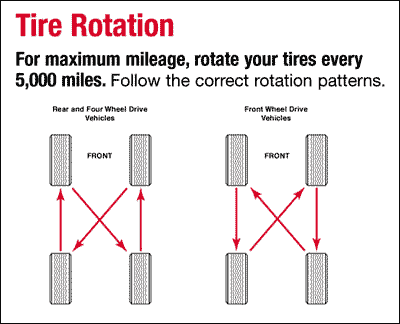 Therefore, you should not drive a car for maintenance with summer tires if it is winter outside, and vice versa. In addition, an important criterion is the coincidence of the model and size of the wheels on the same axle. It should also be borne in mind that the operator always measures the residual depth of the tread pattern and if the result is less than 1.5 mm, then the car will not be allowed to operate.
Therefore, you should not drive a car for maintenance with summer tires if it is winter outside, and vice versa. In addition, an important criterion is the coincidence of the model and size of the wheels on the same axle. It should also be borne in mind that the operator always measures the residual depth of the tread pattern and if the result is less than 1.5 mm, then the car will not be allowed to operate.
When receiving a diagnostic card in winter, when using studded tires, they must be installed on all four wheels, since their partial use is not allowed.
With the introduction of new wheel inspection requirements, fans of improving their car with wheels of non-standard sizes that do not correspond to the sizes recommended by the vehicle manufacturer have been particularly affected. If this is not spelled out in the characteristics of the car, then a car with increased ground clearance or lowered models on fashionable rims will not pass a technical inspection in 2021, since non-compliance with factory criteria is the cause of a violation of vehicle traffic safety.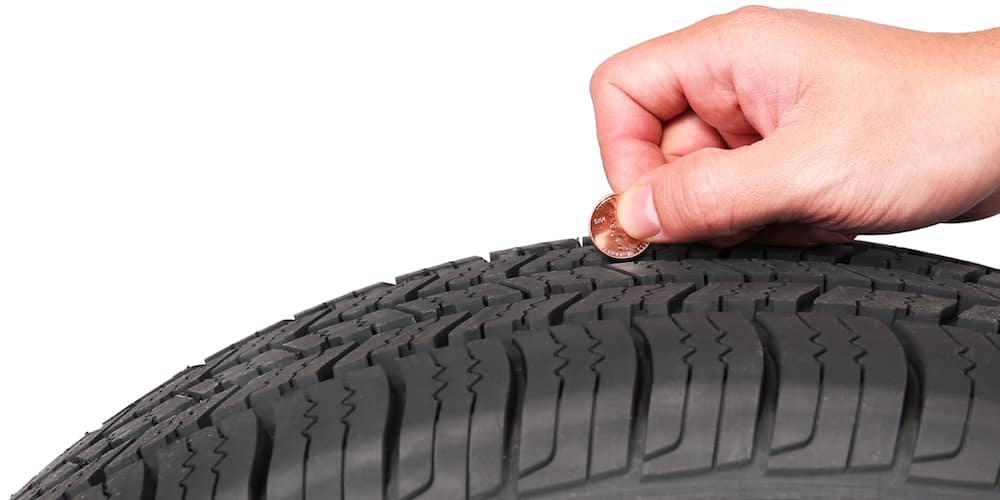 Therefore, before visiting a service station, check that the wheels installed meet the standard specified in the manual for your car. Also, this information can be found on a special plate fixed on the body pillars from the driver's door.
Therefore, before visiting a service station, check that the wheels installed meet the standard specified in the manual for your car. Also, this information can be found on a special plate fixed on the body pillars from the driver's door.
Tires of any models and brands have a certain service life, which, according to experts, cannot exceed 10 years even according to the highest performance and gentle operation. That is why, during the inspection of the vehicle, operators pay special attention to the age of the tires. The date of manufacture is included in the marking of the rubber applied to its side surface. Car owners with wheels older than 10 years are often refused, since the rubber material, even with careful use, ages with the formation of structural changes and deterioration in softness. This leads to worse road grip, poor vehicle stability and an increase in stopping distance. According to experts, it is best to change tires after 5-7 years of use.
During the inspection process, a refusal can be obtained due to inadequate tire quality. The reason for this may be the presence of:
No specialist will issue a diagnostic card if the wheels are not fixed. A missing bolt or nut, as well as the wrong selection of the size of the fastener and its shape, is a guarantee that you will not pass the inspection, since the operation of such a vehicle is strictly prohibited by law.
If you received a refusal to issue a diagnostic card, then do not despair, as you can undergo MOT again. Only before this procedure, it is necessary to eliminate all the comments and bring the car back to normal in accordance with the requirements and rules of the technical inspection in 2021.
Only before this procedure, it is necessary to eliminate all the comments and bring the car back to normal in accordance with the requirements and rules of the technical inspection in 2021.
Vladimir Gavrilov
Estimated reading time: 4 minutes
8120
PavelKant / Shutterstock.com
It's no secret that in the past, when passing inspection, service station employees did not find too much fault with the dimensions of the wheels, which is why many cars went through the tuning procedure and drove for years on non-standard wheels and tires. Now the requirements have become tougher, and getting a diagnostic card for many cars with non-standard wheels is becoming difficult. The same applies to old worn tires with mechanical damage.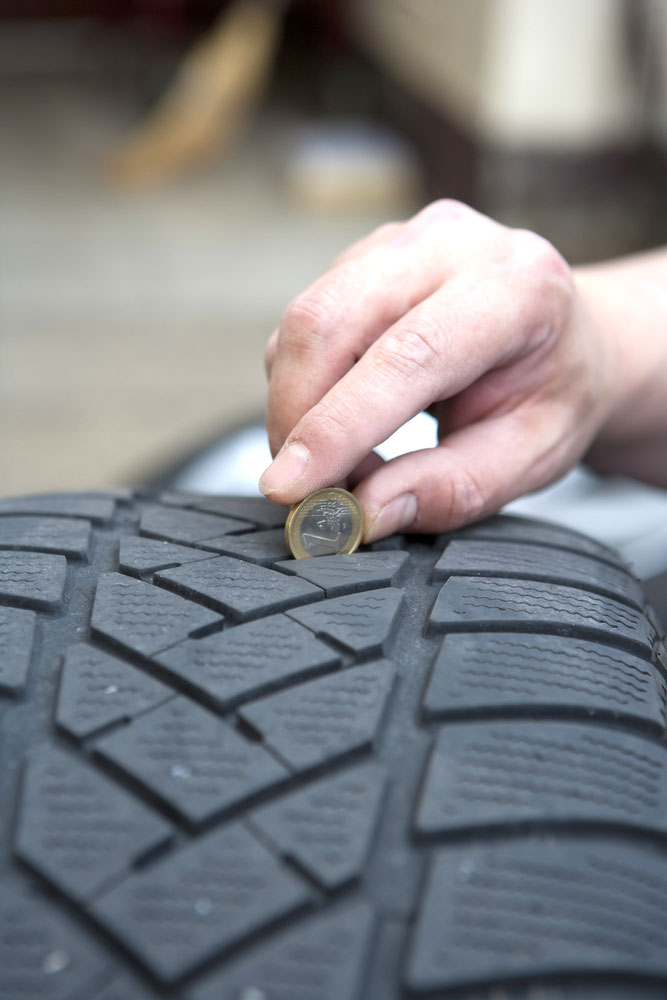 What wheels will not allow you to get a diagnostic card?
What wheels will not allow you to get a diagnostic card?
Many used vehicles have custom rims and wheels installed. Some drivers try to increase ground clearance in this way, while others give the car a more refined sporty look. Now these improvements may cause misunderstanding among the employees of maintenance points. According to the regulations, only rims and tires approved by the manufacturer are allowed to be used on vehicles.
The dimensions of the permitted rims and tires are indicated on a tin plate on the body pillar on the inside of the door.
When examining tires, maintenance specialists pay attention not only to tread wear, which for summer tires should be at least 1.5 mm, but also to the appearance of the wheel. There should be no swelling on the sidewalls, which people call “hernias”. These damages appear as a result of a rupture of the cord inside the rubber layer. Then the integrity of the sidewall is broken, and the air passes through some layers of the material. With the growth of shock loads, the "hernia" often grows, as the cord spreads and is not able to hold pressure.
Repeated mechanical impact on the area of swelling leads to a puncture of the wheel and a sharp drop in pressure, which can lead to loss of control.
Also, do not drive on tattered tires, that is, with lateral damage similar to shells. It happens that at high speed the wheel gets into a hole, touches the edge, and part of the tire material breaks out with the sharp edges of the asphalt. Often, such damage is also caused when driving through roadworks, where asphalt layers were removed with milling cutters. Pieces of the selected rubber can remain on the sidewalls and are clearly visible to the specialist. Such wheels will have to be replaced with new ones, regardless of whether they hold pressure or not.
It will not be possible to pass the inspection even with repaired wheel cuts by vulcanization.
The age of the wheels is also important for obtaining a diagnostic card.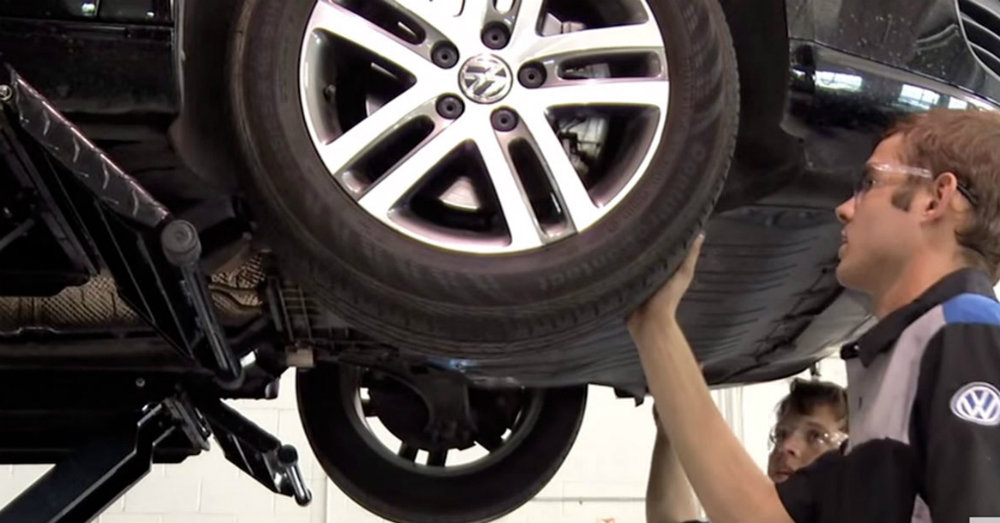 If the tires have low mileage and have not worn out the tread for 10 years, then driving on them is still not allowed. Manufacturers determine the service life of the rubber compound at 5-7 years. And by the age of 10, irreversible structural changes begin in the rubber, which lead to a sharp loss of adhesion of the material to the surface. As drivers say, the wheels "tan" and lose their elasticity. The braking distance on old tires increases dramatically. Therefore, it is better to use mostly new tires. It's safer that way.
If the tires have low mileage and have not worn out the tread for 10 years, then driving on them is still not allowed. Manufacturers determine the service life of the rubber compound at 5-7 years. And by the age of 10, irreversible structural changes begin in the rubber, which lead to a sharp loss of adhesion of the material to the surface. As drivers say, the wheels "tan" and lose their elasticity. The braking distance on old tires increases dramatically. Therefore, it is better to use mostly new tires. It's safer that way.
You can find out the age of a tire by the markings embossed on its sidewalls. Since 2019, a new tire marking has been introduced using DataMatrix codes. Using them, you can see when the goods were imported or produced, determine the country of the manufacturer, etc. According to them, the specialists of maintenance points can recognize old wheels.
It is strictly not allowed to break the wheel fixings. If a fastening bolt or nut is missing or there are cracks in the disc and rims, then these faults will need to be repaired immediately.